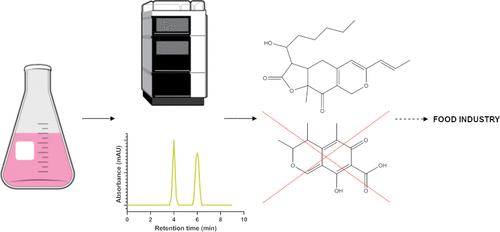红曲霉DBM 4361在潜水培养中的色素形成
IF 6.2
1区 农林科学
Q1 AGRICULTURE, MULTIDISCIPLINARY
引用次数: 0
摘要
由于monacolin k的存在,通常在水稻上种植红曲霉。我们重点研究了沉液培养(SLC)中红曲霉与紫曲霉和橡胶曲霉产生不同的色素。在经典红曲红色素群中,形成了以五碳侧链为主的化合物,主要为红曲红素(monascuspiloin),这是一种与红曲红素结构相似的黄色色素。在SLC中,观察到以前未描述的影响色素形成的模式,例如Crabtree效应,葡萄糖和其他单糖/双糖引起的色素碳分解代谢抑制,以及氮调节,特别是硫酸铵对色素形成的抑制。有机氮源提取液中色素浓度最高,其中蔗糖和色氨酸组合提取的黄色色素为340 mg/L,淀粉和色氨酸组合提取的橙色色素为346 mg/L,乳糖和色氨酸组合提取的红色色素为75 mg/L。本文章由计算机程序翻译,如有差异,请以英文原文为准。

Pigment Formation by Monascus pilosus DBM 4361 in Submerged Liquid Culture
Monascus pilosus is usually cultivated on rice because of monacolin K. We focused on pigment production in submerged liquid culture (SLC) where M. pilosus produced different pigments compared to M. purpureus and M. ruber. From the group of classic Monascus pigments, there were formed mostly compounds with a five-carbon side chain, and the dominant pigment was monascuspiloin, a yellow pigment structurally similar to monascin. In SLC, previously undescribed patterns affecting pigment formation were observed, such as the Crabtree effect, carbon catabolite repression of pigments caused by glucose and other mono-/disaccharides, as well as nitrogen regulation, particularly repression of pigment formation by ammonium sulfate. The highest pigment concentration in the extract was obtained using an organic nitrogen source, specifically 340 mg/L for yellow pigments utilizing a combination of sucrose and tryptone, 346 mg/L for orange pigments using starch and tryptone, and 75 mg/L for red pigments using lactose and tryptone.
求助全文
通过发布文献求助,成功后即可免费获取论文全文。
去求助
来源期刊
CiteScore
9.90
自引率
8.20%
发文量
1375
审稿时长
2.3 months
期刊介绍:
The Journal of Agricultural and Food Chemistry publishes high-quality, cutting edge original research representing complete studies and research advances dealing with the chemistry and biochemistry of agriculture and food. The Journal also encourages papers with chemistry and/or biochemistry as a major component combined with biological/sensory/nutritional/toxicological evaluation related to agriculture and/or food.

 求助内容:
求助内容: 应助结果提醒方式:
应助结果提醒方式:


